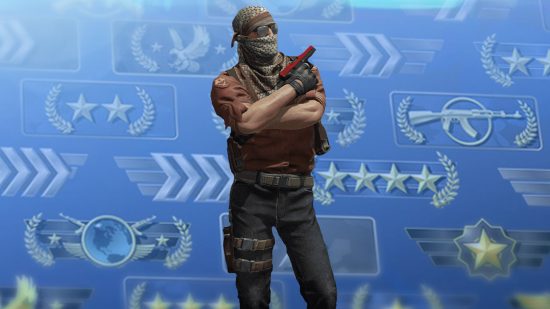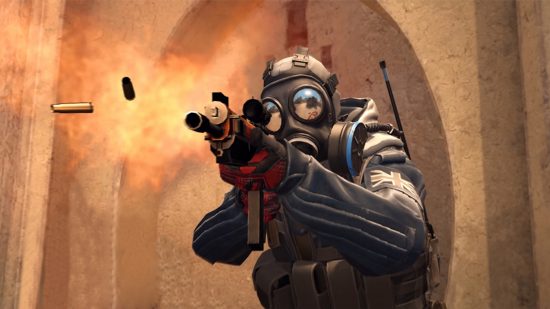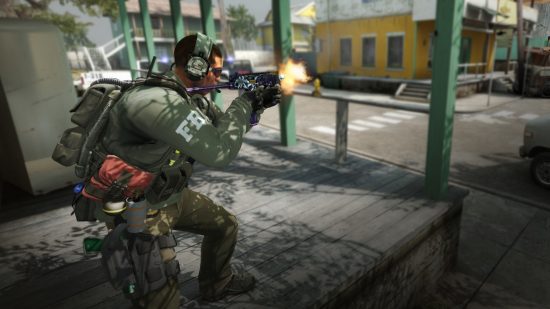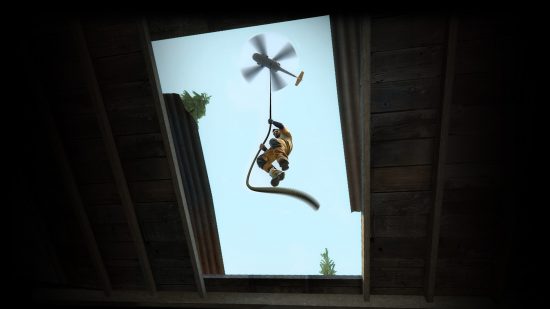How do the CS:GO ranks work? Whether you’re playing with the pros in Global Elite servers or stuck in Silver, ranks are synonymous with Counter-Strike: Global Offensive. CS:GO ranks can be hard to attain and maintain, but understanding the ranking system in the popular Valve shooter is key to working out just how good you are, and what you need to work on.
Not everyone will be able to climb to the dizzying heights of Global Elite, and that’s ok, but the skill gap between the average CS:GO ranks can be far and few between. If you want to improve as a player, you’ll want to get studying, because understanding CS:GO ranking system is crucial to your development.
How do CS:GO ranks work?
CS:GO ranks have been part of the decade old shooter since the very beginning, but Valve has never officially disclosed how you rank up and down in the game, since the MMR number associated with your rank is hidden from view.
However, it’s widely believed that CS:GO ranks are based on your overall performance, as well as your wins and losses. That means you’ll have to work hard on delivering a performance that benefits you and your team.
This is then factored into an invisible matchmaking rating (MMR), which then determines what your rank actually is. The MMR ranges for each rank is unknown, but as you win and lose matches, your MMR number will go up and down.
Win enough matches and outperform both your teammates and your enemies and you’ll find your rank increase steadily.
What are the CS:GO ranks?
CS:GO has 18 ranks, split into six tiers. Where you fit into the ranking system determines how good you are at the classic FPS.
Here are the CS:GO ranks in order:
| Rank | Symbol |
| Silver I | |
| Silver II | |
| Silver III | |
| Silver IV | |
| Silver Elite | |
| Silver Master Elite | |
| Gold Nova I | |
| Gold Nova II | |
| Gold Nova III | |
| Gold Nova Master | |
| Master Guardian I | |
| Master Guardian II | |
| Master Guardian Elite | |
| Distinguished Master Guardian | |
| Legendary Eagle | |
| Legendary Eagle Master | |
| Supreme Master First Class | |
| Global Elite |
Silver is usually associated with new players who haven’t quite got to grips with the mechanics of the game. There’s usually a lack of strategy and communication, which can hinder players trying to better themselves. There’s also the added challenge of smurfs – higher ranked players on fresh new accounts – for Silver players.
Gold Nova is where you’ll find the largest proportion of the CS:GO player base. The skill level among these players varies depending on the rank. Those towards the higher end of the scale are more likely to have better knowledge of managing the economy in-game, each gun’s spray patterns, and smokes.
Master Guardian players are typically more advanced. These players spend time in custom servers learning new ways to use utility and retake sites. If you’re aiming to reach Master Guardian or above, be prepared to stick in some extra hours.
This could all change with the upcoming Counter-Strike 2 release date, but time will tell on that front.
CS:GO rank distribution
While there are plenty of stats and charts out there, it’s important to note that Valve doesn’t officially release information on ranks and therefore there is no confirmed CS:GO rank distribution to look at.
A few third-party sites do track CS:GO rank distribution, but it’s important to note this only takes into account a small sample of the player population and therefore is not representative of the player pool.
What it does suggest, however, is that majority of players are ranked as Gold Nova 3. It is believed less than 1% of CS:GO players are ranked as Global Elite.
How do I get my first CS:GO rank?
When you boot up CS:GO for the first time you’ll have no rank. Like many other competitive games out there, CS:GO players are expected to jump into casual servers to learn the ropes first, before committing to a serious ranked match. Even if you wanted to, you can’t, as all new players must reach Private Rank 2 before diving into the deep end.
To get started, you’ll need to play online matches of various CS:GO modes. Deathmatch or Arms Race are good places to start, as you’ll be forced to try different weapons from various spawn points every time you die. Casual matches are handy too, as they follow the same rules of competitive matches, just with more players on each team.
Once you’ve earned enough XP for level two, you can start searching for competitive matches via the matchmaking menu. You’ll need to complete ten competitive matches to get your first rank. But remember: you’ll be pitched against opponents of varying ranks, so don’t worry if you struggle to get going at first.
You’ll also only be able to earn two wins a day in the process of completing your ten wins. So pace yourself and warm up before launching into competitive.
Once you’ve won your tenth win, you’ll be able to see what rank you’ve earned at the end, when the leaderboard flashes up after the game has concluded.
How do I rank up in CS:GO?
While the process of climbing the CS:GO ranks can take some time, there are a few things you can do to improve your general gameplay.
Here are our CS:GO ranks tips:
- Tailor your game settings
- Practice your aim and learn recoil patterns
- Learn smokes and pop flashes for retakes
- Play with higher ranked friends
Changing your CS:GO crosshair and settings can have an immediate effect, but training your aim will take a bit longer.
Fortunately, there are plenty of custom maps in Steam’s Workshop to help you out. Aim training and recoil maps serve as useful educational tools. There are also YouTube guides that break down utility usage and placement, which can be the difference between Silver Master Elite and Gold Nova I.
The best thing to remember is that experience is key. You’ll learn new tricks from every match you play. Win or lose, there’s always something worth going back and watching again.
If you’re struggling to progress by solo queuing, take a look at the Steam Discussion Board or the Nearby Lobbies option in-game. Make friends with like-minded individuals who would prefer to go all guns blazing with a teammate. Games are, after all, more fun with friends – especially when you’re trying to climb the CS:GO ranks.
Why is my CS:GO rank different for Wingman?
Wingman is a 2v2 mode, played on smaller versions of some of the game’s most iconic maps. CS:GO’s Wingman ranks are the same as Competitive.
As a smaller proportion of the player base play Wingman, many people find that they have a higher rank than their normal one. This is because the ranking system is weighted differently, and because you’re more likely to encounter unbalanced teams frequently – especially if you like playing with friends who have a different rank to you.
What are the Danger Zone ranks in CS:GO?
Danger Zone is a battle royale mode that Valve added to CS:GO in December 2018. It sees 18 players, or nine teams, fight to the death in an ever-shrinking battle arena. As the aim of this mode is vastly different from the game’s primary ranked mode, Valve added new ranks in 2019. Danger Zone can currently be played on three maps: Blacksite, Sirocco, and Jungle.
Here are the CS:GO Danger Zone ranks in order:
| Rank | Symbol |
| Lab Rat I | |
| Lab Rat II | |
| Sprinting Hare I | |
| Sprinting Hare II | |
| Wild Scout I | |
| Wild Scout II | |
| Wild Scout Elite | |
| Hunter Fox I | |
| Hunter Fox II | |
| Hunter Fox III | |
| Hunter Fox Elite | |
| Timber Wolf | |
| Ember Wolf | |
| Wildfire Wolf | |
| The Howling Alpha |
What does Trust Factor in CS:GO mean?
Trust Factor is a system designed by Valve that matches you up with similar players based on your behaviour. Valve has never shared the full list of factors which contribute to a player’s rating, but we do know that behaviour, the age of your Steam account, and your hours in CS:GO and in other games play a part. So if you want to have good games, you better be on your best behaviour.
So there you have it – the full rundown on all things CS:GO ranks. It’ll take time for you to move between ranks, so if you feel like you’re stuck in a rut, take a step back, analyse your game, and go into your next match with a fresh mind. Skins don’t help, but they do make you look good if you clutch a situation, so make sure to check out our list to the best CS:GO skins right here.
Now that CS:GO has been updated to Counter-Strike 2, check out what’s changed with this excellent CS2 ranks guide.



